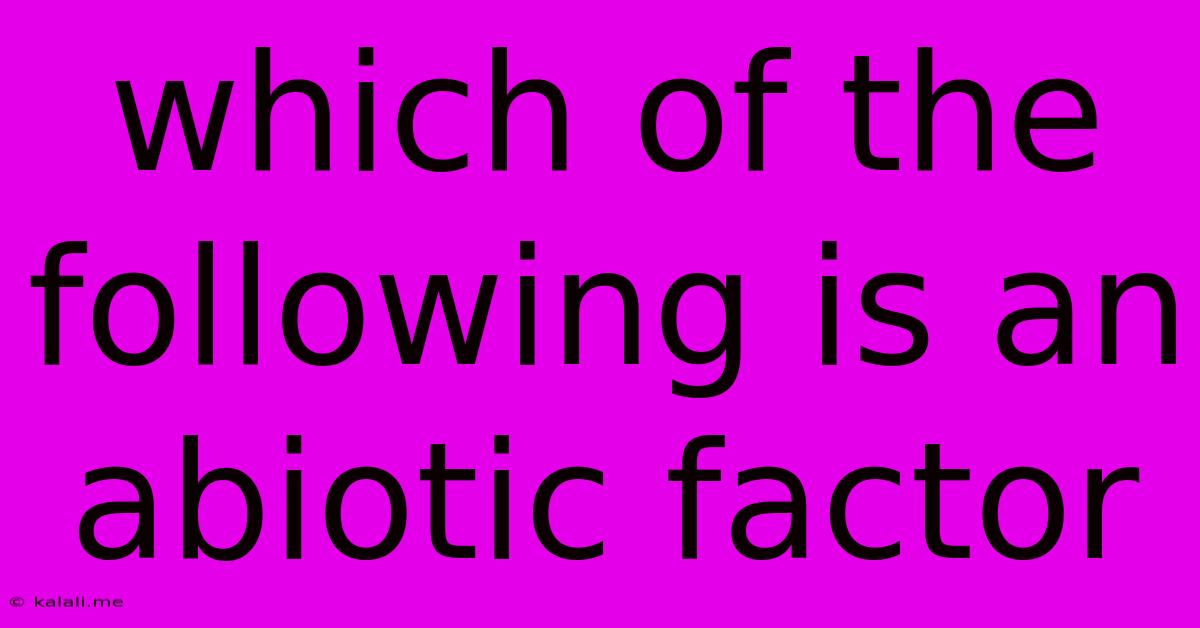Which Of The Following Is An Abiotic Factor
Kalali
Jun 14, 2025 · 3 min read

Table of Contents
Which of the Following is an Abiotic Factor? Understanding Environmental Components
This article explores the concept of abiotic factors in ecology, clarifying their definition and providing examples to help you easily distinguish them from biotic factors. Understanding abiotic factors is crucial for comprehending the intricate relationships within ecosystems. We'll delve into what constitutes an abiotic factor and how it influences living organisms. This will help you easily identify abiotic factors in various scenarios.
What are Abiotic Factors?
Abiotic factors are the non-living components of an ecosystem. These elements play a vital role in shaping the environment and influencing the distribution and survival of living organisms (biotic factors). They encompass a wide range of physical and chemical elements, creating the backdrop against which life unfolds. Think of it as the stage on which the living actors (plants, animals, fungi, etc.) perform their roles. Understanding these non-living components is key to comprehending the health and stability of any ecosystem.
Examples of Abiotic Factors:
Abiotic factors can be broadly categorized, making identification easier:
-
Climate: This includes temperature, rainfall, sunlight, wind, and humidity. These elements directly affect the growth, reproduction, and survival of organisms. Consider how temperature variations influence plant life cycles or how rainfall patterns affect animal migration.
-
Geological Factors: These encompass soil type, minerals, rocks, and landforms. Soil composition, for instance, dictates which plants can thrive in a particular area, while landforms like mountains influence weather patterns and create diverse habitats.
-
Atmospheric Factors: Beyond climate, this category includes oxygen levels, carbon dioxide levels, and air pressure. Oxygen, obviously, is vital for aerobic respiration in many organisms, while carbon dioxide levels affect photosynthesis.
-
Hydrological Factors: These relate to water, its quality, and availability. Salinity, pH levels, water currents, and the presence of dissolved substances all significantly impact aquatic life and surrounding terrestrial ecosystems.
-
Edaphic Factors: These specifically relate to the soil, including its texture, structure, pH, nutrient content, and water-holding capacity. Different soil types support different plant communities, influencing the wider ecosystem.
Distinguishing Abiotic from Biotic Factors:
The key difference lies in the presence of life. Biotic factors are living components – plants, animals, fungi, bacteria, etc. – while abiotic factors are non-living. Sometimes, the distinction can be subtle. For example, dead organic matter is technically abiotic, even though it originated from a living organism.
Identifying Abiotic Factors in a Given Scenario:
Let's consider a hypothetical scenario: You are presented with a list: Sunlight, Oak Tree, Water, Bacteria, Temperature.
Which are abiotic? The answer is sunlight, water, and temperature. The oak tree and bacteria are biotic factors. This exercise highlights the importance of understanding the fundamental difference between living and non-living components of an environment.
Conclusion:
Recognizing abiotic factors is fundamental to understanding ecology. By appreciating their influence, we gain a more complete picture of ecosystem dynamics and the complex interactions between living organisms and their environment. This knowledge is essential for various fields, from conservation biology to agriculture, helping us to better manage and protect our planet's diverse ecosystems.
Latest Posts
Latest Posts
-
Physiological Density Is The Number Of
Jun 15, 2025
-
Cover Letter Examples For Visa Application
Jun 15, 2025
-
Lcm Of 5 4 And 2
Jun 15, 2025
-
How Many Distinct Real Solutions Does The Equation Above Have
Jun 15, 2025
-
Difference Between Criminal And Tort Law
Jun 15, 2025
Related Post
Thank you for visiting our website which covers about Which Of The Following Is An Abiotic Factor . We hope the information provided has been useful to you. Feel free to contact us if you have any questions or need further assistance. See you next time and don't miss to bookmark.